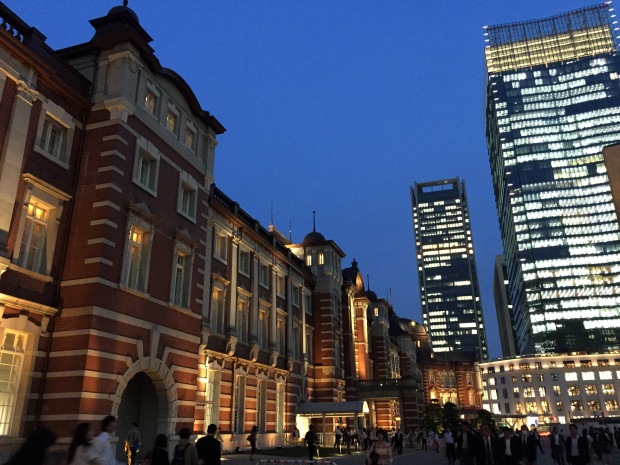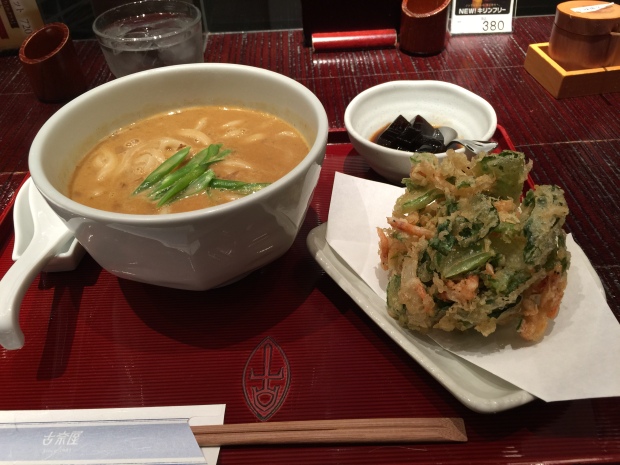The most awaited post – RAMEN!!
The one thing you MUST eat at when you visit Japan is ramen. It’s a staple of Japanese food and probably the most popular food you will come across in Japan. There is a store selling ramen at every corner on every block. Last time, we really enjoyed Ippudo’s tonkotsu in Ginza, but this time, we ventured out to try the weird and wonderful and let me tell you, it was absolutely wonderful.
Inoue (井上)
Now for our favourite Tsukiji Market walk-in outdoor ramen joint. We just had our amazing Sushi Dai omakase and we needed a top up so we hit this place up. This place really hits the spot in the spring or fall when it is still a bit chilly outside and you need something to warm you up. Inoue customers devour their ramen huddled over their bowls slurping while standing stooped over a standing table on the sidewalk just outside tsukiji market.
Inoue ramen has only 1 item on the menu, Shoyu Ramen, and opposite to Ichiran, they offer no customization. The way it is served is the way you are meant to enjoy it. It comes piping hot in a clear light brown shoyu broth with a liberal amount of scallion. The noodles are medium thickness and slightly on the softer side of the spectrum, but still firm enough to give you some texture when you bite into them. The broth is light, but has enough flavour from the soy sauce to provide that savoury length. The chashu slice are large, but not seasoned much, so it retains a lot of that pork taste.
Inoue is by no means the best shoyu ramen joint in Tokyo, but it has charm, and it certainly hits the spot every time while visiting tsukiji market. It warms the body and the soul.
Rokurinsha
We started off our ramen tour with a bowl of the famous tsuekemen from Rokurinsha. This bustling ramen shop was at the end of Ramen Street in the basement of Tokyo Station. We queued for about 20-30 minutes. The wait couldn’t have felt any longer because you can see and hear the slurping of delicious ramen by the customers inside.
We ordered the ajitama Tsukemen (original tsukemen with a flavoured soft boiled egg) and the Tokusei Tsukemen (Original tsuekemen with shredded pork). Rokurinsha is very thoughtful. They provide customers with a tie around apron because they know there will be splash damage from the ramen as customers slurp their way through their massive bowls of noodles.
The ramen came in 2 separate bowls. One heaping bowl of cold ramen and a bowl of hot ramen soup (or should I say sauce). The noodles were thick, chewy, and hearty. It was perfect in combination with the rich dipping sauce. The sauce had an incredibly hearty taste of meat from the pork and chicken with a blast of seafood umami from the dried sardines, mackerel, and bonito. The almost overpowering sauce was perfectly balanced with those thick noodles which were able to soak up a lot of the sauce but provided that starchy balance to make it a perfect harmony.
Ichiran

I loved Ichiran. Other than their deliciously rich and silky tonkotsu style ramen, the other unique thing about Ichiran is that they limit your interaction with other customers and other staff from little to none. Once you pay for your meal at the vending machine and your are seated, you find yourself in a small cramped one-person cubicle with a narrow window in front of you. The window opens and you are handed a customization form for your ramen. You can choose the firmness of your noodles, how rich the broth is, level of spiciness, and the quantity of the toppings you would like included such as garlic, pork, and scallion. Once ready, you ring the bell, the window is opened by the server on the other side, they grab your form, and again the window is closed. In minutes, the window opens again and your ramen is inserted through it and voila, your meal is served.
The noodles, broth, and other customizations are done to the exact specification that you ordered. The thin type of noodles are my favourite and the normal firmness have enough bounce to make things interesting. The broth is creamy, silky, and rich. I asked for the recommended level of spiciness and found it added a pleasant dimension to the already very flavourful broth. It didn’t overpower the flavour of the tonkotsu broth, but rather complemented it. The chashu was nothing special to write home about, but certainly did not take away from the tasty bowl of ramen.
My quiet, solitary experience was a pleasant one and perfect for a peaceful quick bite to eat in the hustle and bustle of Tokyo.
Kinryu Ramen

Before we headed into Universal Studios, we had to stop at dotonburi (道頓堀) to get both the famous Osaka takoyaki as well as some ramen.
We were a little disappointed in general with the tonkotsu at Kinryu, as the noodles were too soft and soggy, even at the beginning of the day. The broth was meaty but not creamy rich as tonkotsu is known to be, and undecided in what flavour it wants to resonate through. The mouthfeel was fatty, yet lacked the reason to be, and the pork was stale and tough. Although the it had a fancy sign, the ramen was not so fancy.
Gogyo Ramen
Umami! Umami! Umami! That’s all I can say.
We were so upset when we first arrived in Kyoto and found this place closed for renovations. But, we were determined to have burnt ramen before we left Japan. So, we decided to give it one last try and on our second last day in Kyoto, they had reopened and we were able to have one of our favourite bowls of ramen in Japan. Karen ordered the Shoyu burnt ramen and I ordered the Miso burnt ramen. Both were similar as the burnt flavour overpowers the other flavours of the broth – not that it’s a bad thing.
By burning the fat on top of the broth, it creates a rich smokey flavour that is unlike any other ramen we’ve tried. If you’ve had David Chang’s momofuku ramen, the smokiness is nothing like that. Momofuku has a more woody, wispy type of smokiness whereas gogyo has a fuller and more intense smoke taste that gives the broth a kick of umami.
The noodles were good, medium thickness, and firm. The meat was fatty and held good flavour. But again, as most ramens do, it was the broth that was the star of the show.
Definitely a must visit if you’re in Kyoto or Tokyo, gogyo gives an interesting twist to ramen culture.
Mamezen Ramen
Mamezen ramen was by far the most amazing ramen we’ve ever had. The reason was simply because although it was radical in ingredient choice, it exceeded the richness and fullness of flavour compared to meat-based broths. The broth was incredibly rich, creamy, and smooth, with an aftertaste of tofu umami.
The noodles were thin but chewy, and the silky broth clung on the noodles as we slurped them with excitement. The yuba (raw skin of tofu) was smooth and thin, the texture complimented the creamy broth extremely well.
They also were one of the most difficult shops to find and track down, snuggled in the residential area of upper Kyoto. When we finally made it to the shop, we were greeted by taro himself, the creator of the silken tofu ramen. He was cheerful and patient with his patrons, getting to know us, chatting with us about the snowy plains of Canada after learning where we were from.
We left after tasting mamezen’s tofu cheesecake, feeling satisfied and accomplished after finding the gem of Kyoto.
We highly recommend the trek to find and enjoy this unique ramen, as it changed the way we saw Japanese soup noodles forever.
-thomas















































































